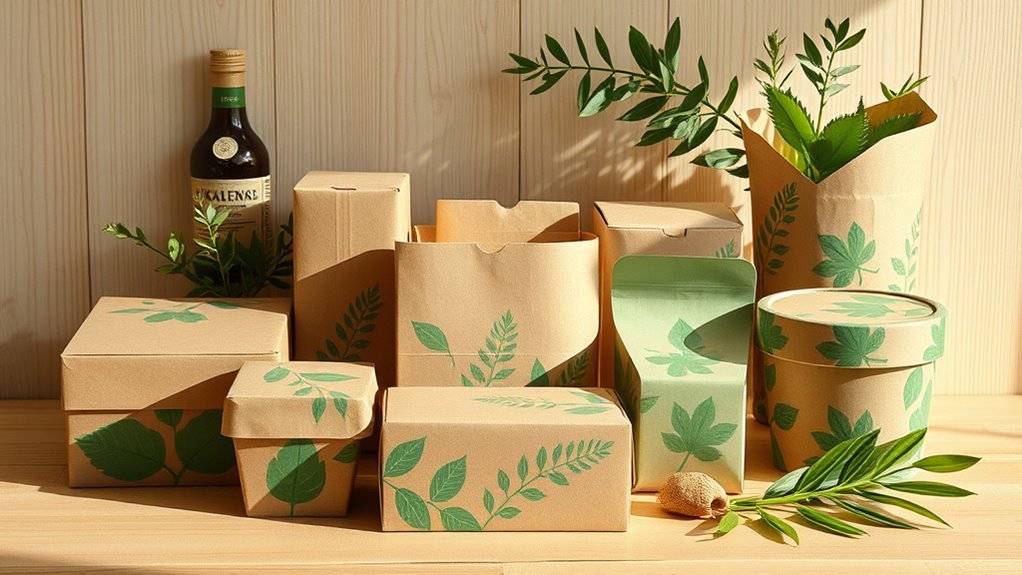Switching to eco-friendly packaging doesn’t have to eat into your profits. By choosing biodegradable options like paper-based materials or compostable fillers, you can reduce waste and appeal to eco-conscious consumers without sacrificing durability. Smart sourcing from responsible suppliers helps keep costs in check while boosting your brand’s green image. If you continue exploring, you’ll discover practical ways to balance sustainability, cost, and durability—all while protecting your margins.
Key Takeaways
- Choose biodegradable materials like plant-based plastics and paper to reduce environmental impact without significantly increasing costs.
- Source eco-friendly packaging from FSC-certified suppliers to ensure sustainability and maintain brand integrity.
- Opt for innovative, durable biodegradable options that protect products effectively while keeping margins intact.
- Communicate your sustainable packaging practices transparently to enhance brand loyalty and justify premium pricing.
- Balance eco-materials with cost-efficient production methods to maximize sustainability benefits without compromising profitability.

As more companies and consumers prioritize sustainability, choosing eco-friendly packaging options has become essential. You’re likely exploring ways to reduce your environmental impact without sacrificing your profit margins. One of the most effective strategies is to incorporate biodegradable alternatives into your packaging lineup. These materials break down naturally over time, minimizing waste and reducing landfill overflow. By switching to biodegradable plastics, paper-based packaging, or compostable fillers, you can demonstrate your commitment to sustainability while appealing to eco-conscious customers. It’s important to guarantee these biodegradable options are sourced responsibly, emphasizing sustainable sourcing practices. When you select packaging made from renewable resources, you’re not only reducing your carbon footprint but also supporting responsible supply chains that prioritize environmental stewardship.
Choosing eco-friendly packaging isn’t just about the materials you use; it’s also about how you source those materials. Sustainable sourcing ensures that your packaging materials are harvested or produced in ways that don’t deplete natural resources or harm ecosystems. For example, opting for packaging made from FSC-certified paper guarantees that the raw materials come from responsibly managed forests. Similarly, working with suppliers who prioritize fair labor practices and environmental standards helps solidify your company’s commitment to sustainability. When you integrate sustainable sourcing into your supply chain, you’re not only reducing environmental impact but also strengthening your brand’s reputation among customers who value transparency and responsibility. Additionally, selecting safe and energy-efficient heated mattress pads can further align your product offerings with eco-friendly standards, emphasizing safety and energy conservation.
Sustainable sourcing of packaging materials builds trust and enhances your brand’s reputation.
While switching to biodegradable alternatives and ensuring sustainable sourcing might seem costly at first, it can actually save you money in the long run. These materials often come from renewable sources and may require less energy to produce, which can lower manufacturing costs. Plus, eco-conscious consumers are willing to pay a premium for products packaged sustainably, giving you a competitive edge. You also benefit from fewer regulatory hurdles and potential incentives offered for environmentally friendly practices. By making these strategic choices, you avoid the costly penalties associated with non-compliance or waste management issues.
Ultimately, adopting eco-packaging options that incorporate biodegradable alternatives and prioritize sustainable sourcing can help you preserve your margins while advancing your environmental commitments. It’s about finding the right balance—using innovative, eco-friendly materials that offer durability and protection without inflating costs. When you communicate your sustainable efforts clearly to your customers, it enhances loyalty and trust. In a marketplace increasingly driven by environmental awareness, these choices position your brand as responsible and forward-thinking, ensuring your business remains competitive and profitable well into the future.
Frequently Asked Questions
How Do Eco-Packaging Options Impact Overall Supply Chain Costs?
You should consider how eco-packaging options impact your supply chain costs through detailed cost analysis. Switching to sustainable materials may initially increase expenses, but it can lower long-term costs via supplier negotiations and reduced waste management fees. These options might also improve your brand reputation, leading to increased sales. By carefully evaluating these factors, you can make informed decisions that balance environmental benefits with cost efficiency, ultimately supporting your business goals.
Are Eco-Friendly Materials as Durable as Traditional Packaging?
Did you know that 70% of consumers prefer eco-friendly packaging? When comparing durability, eco-friendly materials often face biodegradability concerns, raising questions about their strength. While some biodegradable options may seem less sturdy than traditional packaging, advances in material science have improved their durability. Overall, many eco-friendly materials now match traditional packaging in strength, making them a viable, sustainable alternative without sacrificing durability.
What Certifications Should I Look for in Sustainable Packaging?
When choosing sustainable packaging, you should look for certifications that verify recycling standards and eco label credibility. These certifications guarantee the materials meet environmental guidelines and are genuinely eco-friendly. Look for labels like FSC, PEFC, or Green Seal, which demonstrate responsible sourcing and safe disposal. By selecting packaging with reputable certifications, you help protect the environment without sacrificing quality or your margins.
How Can Eco-Packaging Improve My Brand’S Environmental Reputation?
You can boost your brand’s environmental reputation by adopting eco-packaging that aligns with your sustainable brand messaging. Using eco-friendly materials shows your commitment to sustainability, which enhances consumer perception. Transparent communication about your packaging choices builds trust and demonstrates your responsibility. As a result, customers view your brand more favorably, increasing loyalty and differentiation in a competitive market. Eco-packaging isn’t just a practical choice; it’s a strategic move to reinforce your eco-conscious image.
What Are the Best Practices for Disposing of Eco-Friendly Packaging?
When it comes to disposal methods, you want to stay ahead of the curve. Follow recycling guidelines closely to guarantee eco-friendly packaging doesn’t end up in the wrong bin. Educate your team and customers about proper disposal practices. Consider composting biodegradable materials where possible. Proper disposal not only reduces environmental impact but also reinforces your brand’s commitment to sustainability—proving that actions speak louder than words.
Conclusion
So, next time you’re tempted to cut costs with cheap packaging, remember: eco-friendly options don’t have to melt your margins. Ironically, investing a little more upfront in sustainable packaging can actually save you money and boost your brand’s reputation in the long run. Who knew that doing the right thing for the planet could be the smartest business move? So go ahead—choose eco-packaging and watch your profits—and the planet—thrive.









